Post by codystarbuck on Dec 29, 2019 19:26:38 GMT -5
Detective Comics #600

Detective Comics #600 featured the conclusion to a story by Batman movie scripter Sam Hamm, with art by Denys Cowan and Dick Giordano. At the back of the book were tributes from noted artists and writers. Alan Brennert contributed a text piece, with a Berni Wrightson illio, in the background...
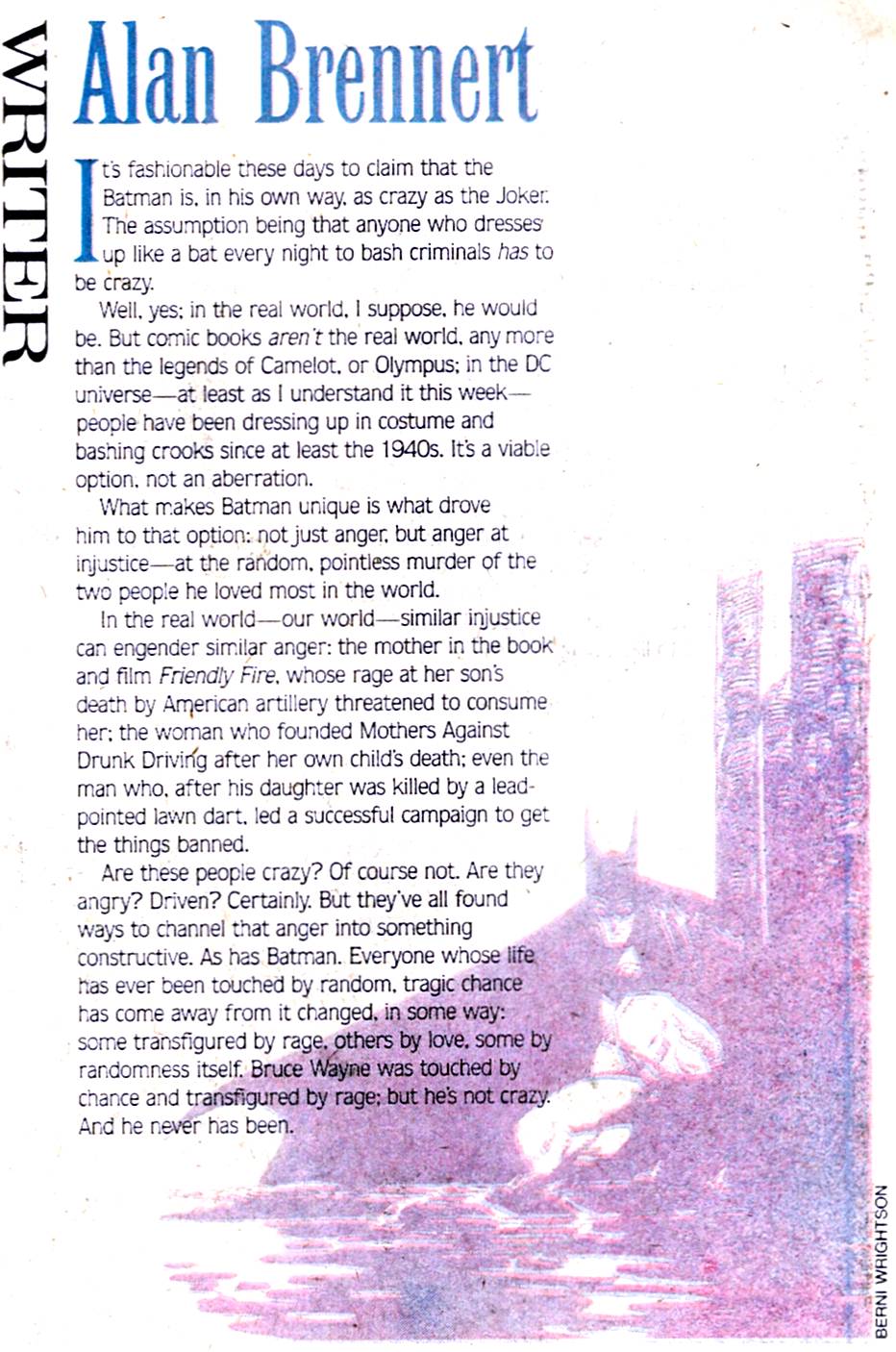
Brennert refutes the then-popular (and since, really) notion that Batman is psychotic. Brennert points out how people channel anger over injustice and equates that with Batman, rather than psychoses. this is why I wasn't wholly satisfied with the Burton Batman and had major issue with the sequel, and most movies ever since. The animated series guys "got it," where the live action people didn't; Batman was obsessed; but, he wasn't nuts. Hollywood struggled to portray the analytical side and none of the films really feature much detective work, beyond stumbling over obvious clues, or gaining info through fantasy technology. BTAS and Brenenrt's stories had actual detective work.
That was Brennert's sole contribution; but, he did contribute another story to DC, later in the year....
Christmas with the Super-Heroes #2

This issue features some great Christmas stories. Since we have discussed the Alan Brennert tale a great deal, in the Twelve Days of Christmas thread, I want to highlight the others, as well as share my thoughts on the Brennert story.
Ex-Machina
Story and art by Concrete creator Paul Chadwick, letters by John Costanza, colors by Tom McCraw, edited by Mark Waid.
On a snowbound highway, a man tries to flag down help. No one will stop. He collapses in despair and pulls a revolver out of the glove compartment and writes a suicide note. There is a knock on the window...
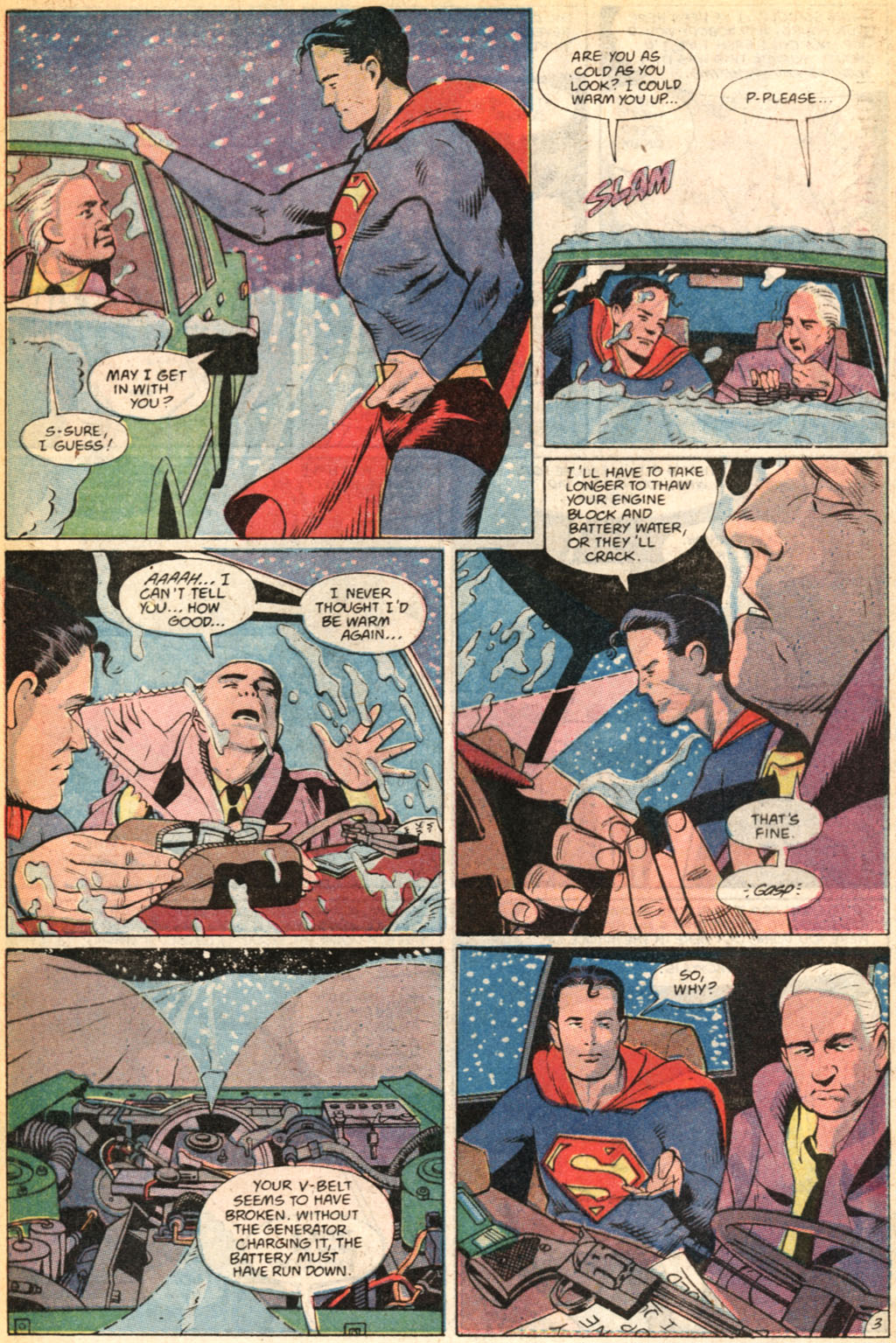
Superman listens to the man's story and empathizes with him. He and his wife have split and he is estranged from his daughter. he has a debilitating disease that affects the skin and muscles. Superman encourages him to get in touch with his daughter and tells him that anyone who has lost a parent would be glad to have them again, even for a short moment, from his own experience. Superman hand turns the generator to charge the car battery and gives the man directions to some friends in the area who can help, telling him he will call ahead and alert them. He tells the man to take the next exit, but to keep these people secret, as they are good friends and private people. The man heads on down the road and takes the next exit, to Smallville.
Thoughts: This is a nice, quiet tale, in Chadwick's tradition in his Concrete tales. It is filled with humanity and demonstrates why Superman can be such a powerful character, in the right hands. All he does is sit down and listen to the man, letting his voice be heard by someone who truly cares. He helps him get back on the road and direct him to others, who care about their fellow human beings. The superpowers are minimal, the humanity is enormous. It is the spirit of Dickens and Phillip Van Doren Stern (author of the original short story, It's a Wonderful Life). Peace on Earth, Good Will to all Mankind. All Men and Women are our brothers and sisters and the more we embrace that, the better the world becomes. Superman, an orphan from another world, was taught to care for all life, by two humans, who took him in and shaped who he became. That nobility is what makes Superman who he is, not the powers and too many writers and artists can't grasp that.
And in the Depths
Story by Dave Gibbons, art by Gray Morrow, letters by John Costanza, edited by Mark Waid
The story is the tale of the Batcave, as we see it across centuries and decades, as the shadows create darkness and terror, until a boy named Bruce stumbles into it. His world becomes darkness and he reenters the cave and creates a base from which to gain revenge. Then light comes to him in a child, who becomes a partner and the darkness fades...
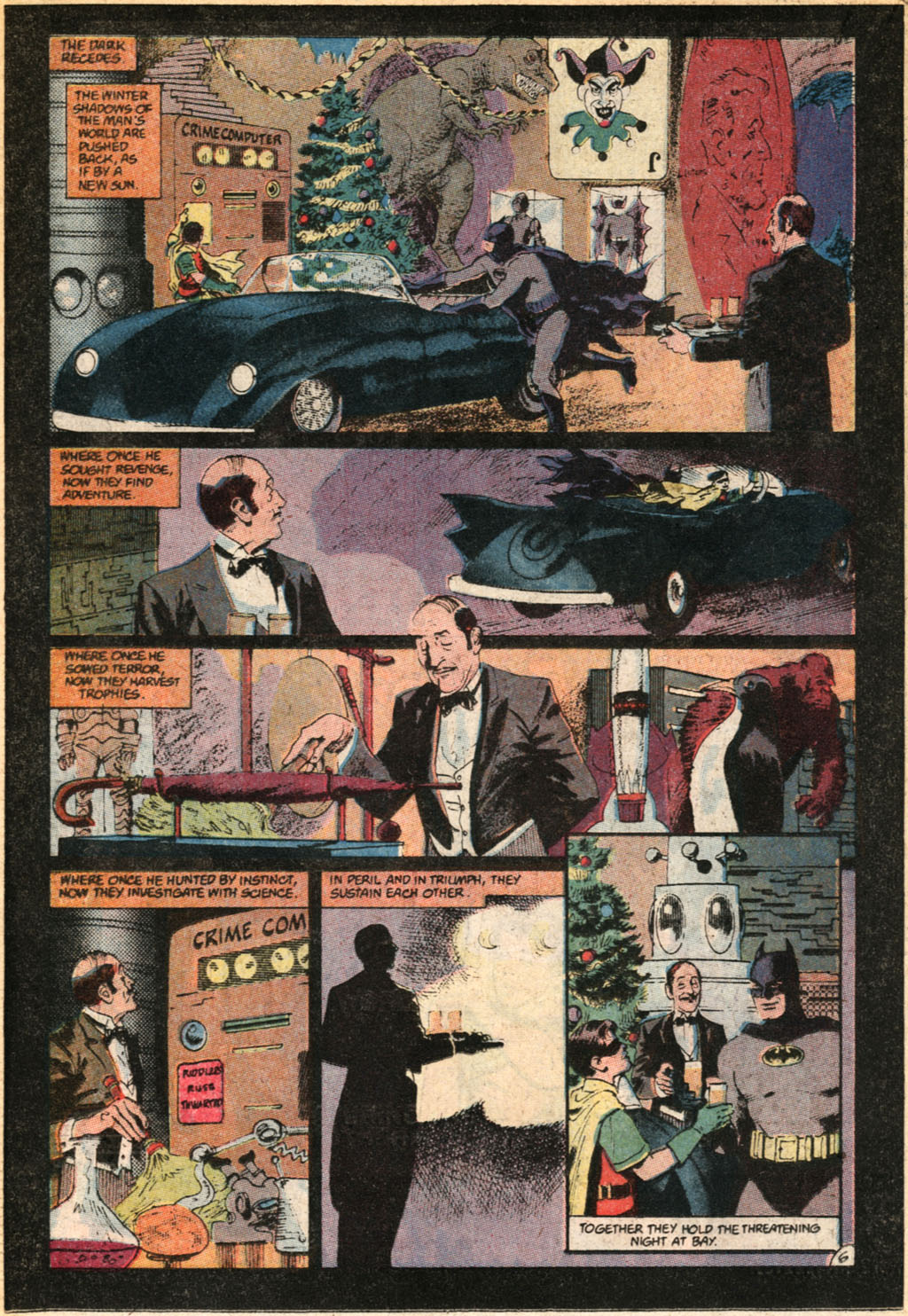
The boy grows to be a man and goes out on his own, and darkness returns. However, at the end, as a stricken robin falls into the cave and is about to become prey for the bats, we see it fight back and scare away the bats, as we see the costume in the background and light returns.
Thoughts: Gray Morrow's art makes it look great; Dave Gibbons tells an interesting tale and illustrates how Bruce extending his humanity to another helps push back against the darkness. It's not as effective as the Superman story, or the Brennert tale; but, it's a good effort, especially since Gibbons isn't primarily a writer.
Gifts
Story and art by Eric Shanower, colors by Tom McCraw, edited by Mark Waid
Christmas at Julia Kapatelis house. Julia sees the arrival of an old college friend, Sharon Jackson. They have seen each other since Sharon's wedding; but, she confesses that her husband is divorcing her, after he has an affair with a woman on the church council (Sharon is a pastor). Church guidelines state she most go to a new congregation, after a divorce and she is afraid of starting over and is thinking of going backto school, to finish her doctorate. Julia lends a sympathetic ear and Sharon stays with her for the holidays. Diana shows up and surprises Sharon, and they talk briefly, about what a pastor does and about Diana's mission and heroics and see their commonality in their beliefs. They listen to crolers and Diana takes part in a Christmas Eve service at the church. That night, Sharon is putting out some final presents and finds Diana staring out the window. Diana breaks down and shares her crisis of faith over her mission...
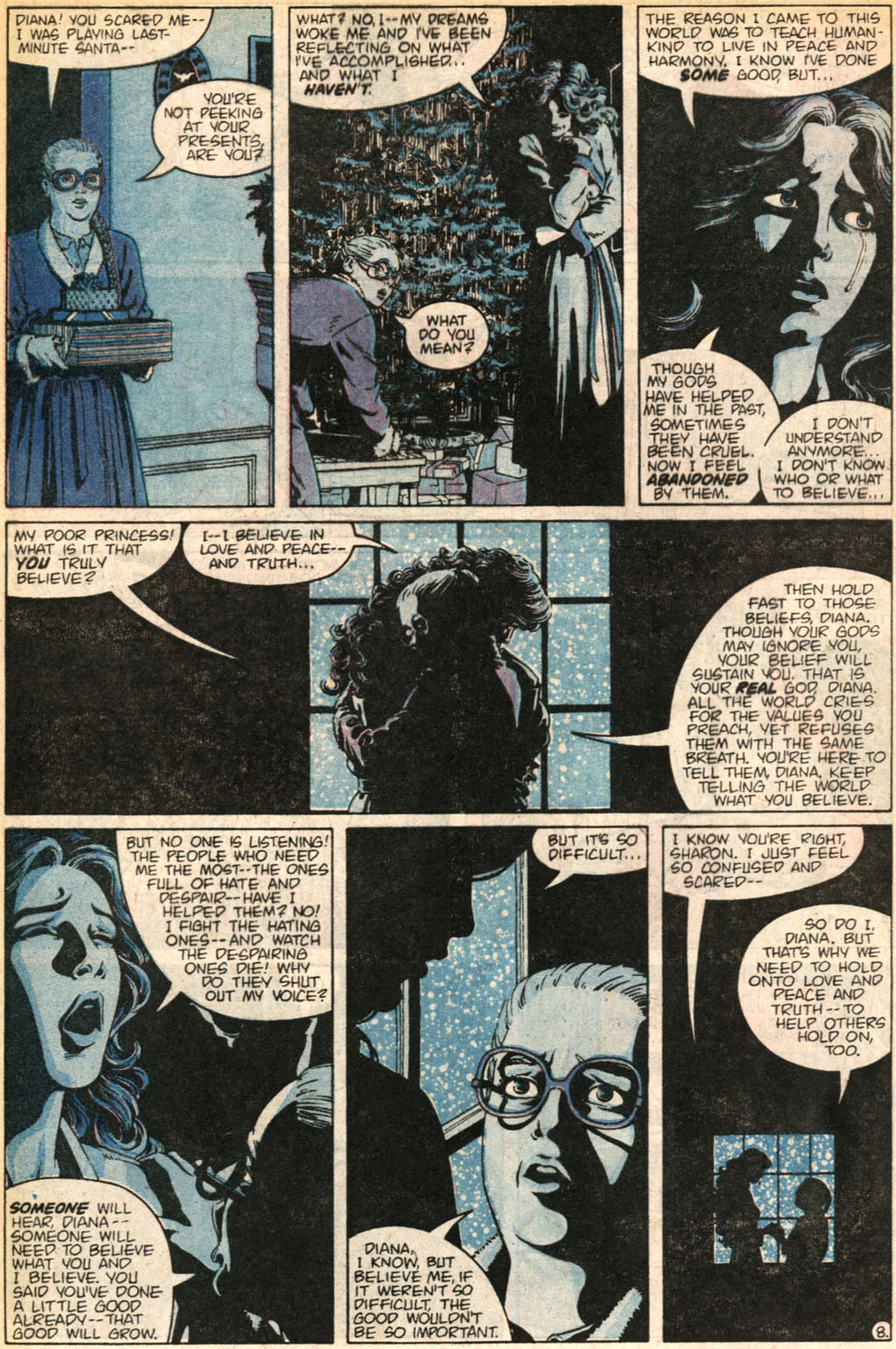
Sharon helps Diana find the strength to carry on, that each it of good plants a seed in others that will grow. In so doing, it helps restore Sharon's own faith in her ability as a pastor and she tells Julia, in the morning, that she will return to the ministry and go to a new congregation that needs her.
Thoughts: Another gentle tale showing how Diana's core beliefs are no different from those at the heart of other religions and philosophies and how that commonality allows a Christian pastor to counsel her about her gifts and her mission and restores her faith in herself. In the process, Diana's need for Sharon's counsel restores Sharon's faith in her own mission to minister to others. Both women share fundamental beliefs and both face doubts i their ability to relate those beliefs to help others; yet, in comforting each other, they restore their faith and continue in their similar missions. The story is reverent to both Christian core belief and Diana's message, derived though it may be from what a Christian might call pagan belief. It reminds us that most religions share the same message, when you look beyond the surface; how to live in eace with one another and share love with others. For that peace and love to come, we must look beyond the differences and focus on the commonalities. Again, humanity is a central theme. Our heroes take a moment to share human failings and triumphs and help a fellow human in need.
Silent Night Story and pencils by John Byrne, finishes by Andy Kubert, colors by Glenn Whitmore, edited by Mark Waid. Dedicated to Joe Kubert and Robert Kanigher.
Christmas, some time during World War I. Ata hospital, a nurse tends to wounded airmen on the Allied side. A young pilot, with head wounds, sketches the pane of the man who shot him down: Rittmeister Hans Von Hammer. Another man tears them out of the nurse's hands and berates the pilot for glorifying their enemy. We see the list of names of men missing or dead. We also see that they have been without supplies for days and food is becoming scarce. Then, they hear a noise and see an aircraft land. It is a Fokker DR7 Triplane, and it is the aircraft of Von Hammer. He presents the hospital with packages of food and is invited to join them in a feast. He dances with the pretty nurse, then sees the board of the missing and dead and renders honors to them...
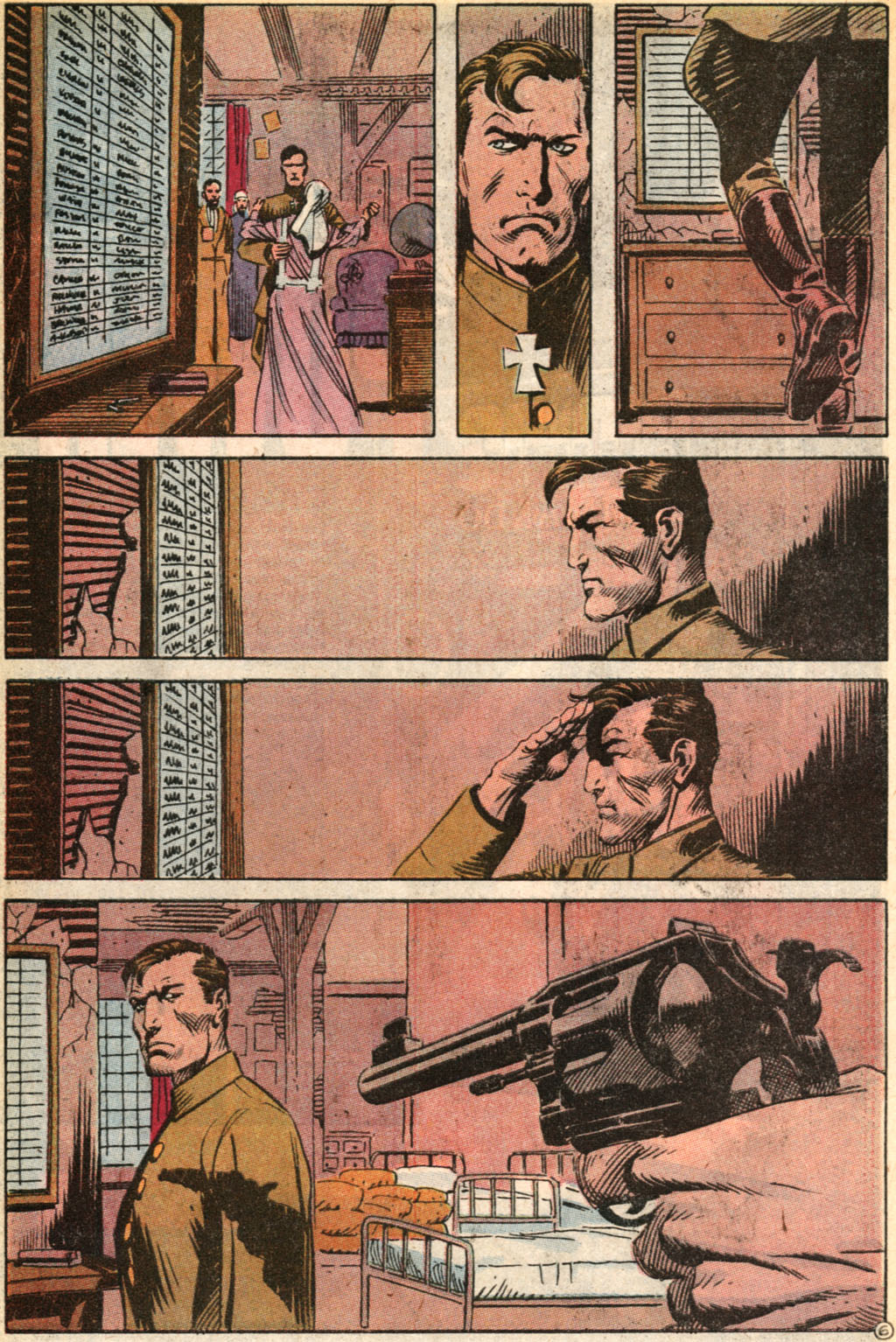
The young pilot turns a revolver on him and is ready to fire. Von Hammer does nothing, as he understands. The youth is stopped by the other pilot who tore up his drawings. He points to the sky, reminding the lad it is Christmas, and a truce. He then points outside and Von Hammer departs, paying his respects to the nurse as he goes. he flies away, leaving behind the fellowship that was there, for a brief moment.
Thoughts: John Byrne perfectly captures the look and tone of the Enemy Ace stories, as the honorable Von Hammer offers his own tribute and fellowship during a Christmas truce. We are reminded of the Christmas miracle of the winter of 1914, when both sides stopped killing one another, in respect for the season. Carols broke out across no man's land and the soldiers rose out of the trenches and extended their hands in friendship, rather than bayonets. They exchanged food and cigarettes, shared photos of family and played football, sharing their humanity. It came to an end and they return to their own sides and then resumed killing one another, after the truce. It was not repeated, though there were still tales of individual incidents, as the war dragged on. The story is told silently, fitting the title, with the art carrying the story and emotion and it is one of Byrne's best jobs, even as he tries to capture the style of Kubert (aided by Andy's inks, no doubt). It emphasizes the triumph of the human spirit, and the stupidity of war, that moments like that couldn't get men to see that the bloodshed was accomplishing nothing and that it needed to stop, permanently. No matter how many times we go through this, we never seem to learn the lesson, that all life is sacred and we share more in common than our national identities and political ideologies illustrate.
An Old Fashioned Christmas
William Messner-Loebs-story, Colleen Doran-pencils, Ty Templeton-inks, Albert De Guzman-letters, Tom McCraw-colors, edited by Mark Waid
In a tale from the past, Hal Jordan joins Barry Allen on monitor duty. When Barry's shift is up, the friends go in search of an old fashioned Christmas. They beam down, but find it rainining, instead of snow. They give some money to a street corner Santa, who talks about how people are nothing, without money. They are having trouble finding the Christmas spirit and a cry for help gets them to stop some muggers. Their victim is CB Fenster, one of the richest men on Earth. He decries how small and petty people are and relate how he offered his guests $5 million to prove the existence of Santa. He remembers a time, wehn he was young, when Santa seemed to exist and people were kind. Flash and GL set out to prove him wrong. Flash gets presents from stores in Hawaii, while GL fashions a Santa suit for Fenster. They take him around to be Santa and help him get down chimneys. he gives a teddy bear to a pair of kids, who thought he'd be more inspiring. He helps a rich widow assemble bikes that her late husband ordered before his death. he meets an elderly Jewish man, who works so that Christians can spend time with family, who would just like some company. They look for the Harper family, the last on the list, but find only a burnt down house. Flash and GL give up and Fenster finds the family, sleeping in their car, unable to afford a place to stay. He offers them presents but the father tells him to take them to the shelter, where others are worse off. he has sardines for his wife and a silk rose he found outside a florist and is happy. Flash and GL return and Flash tells Fenster they have found the Santa Fenster was looking for and show him his own reflection. he starts to hand them the money and they refuse, saying use it to help others.
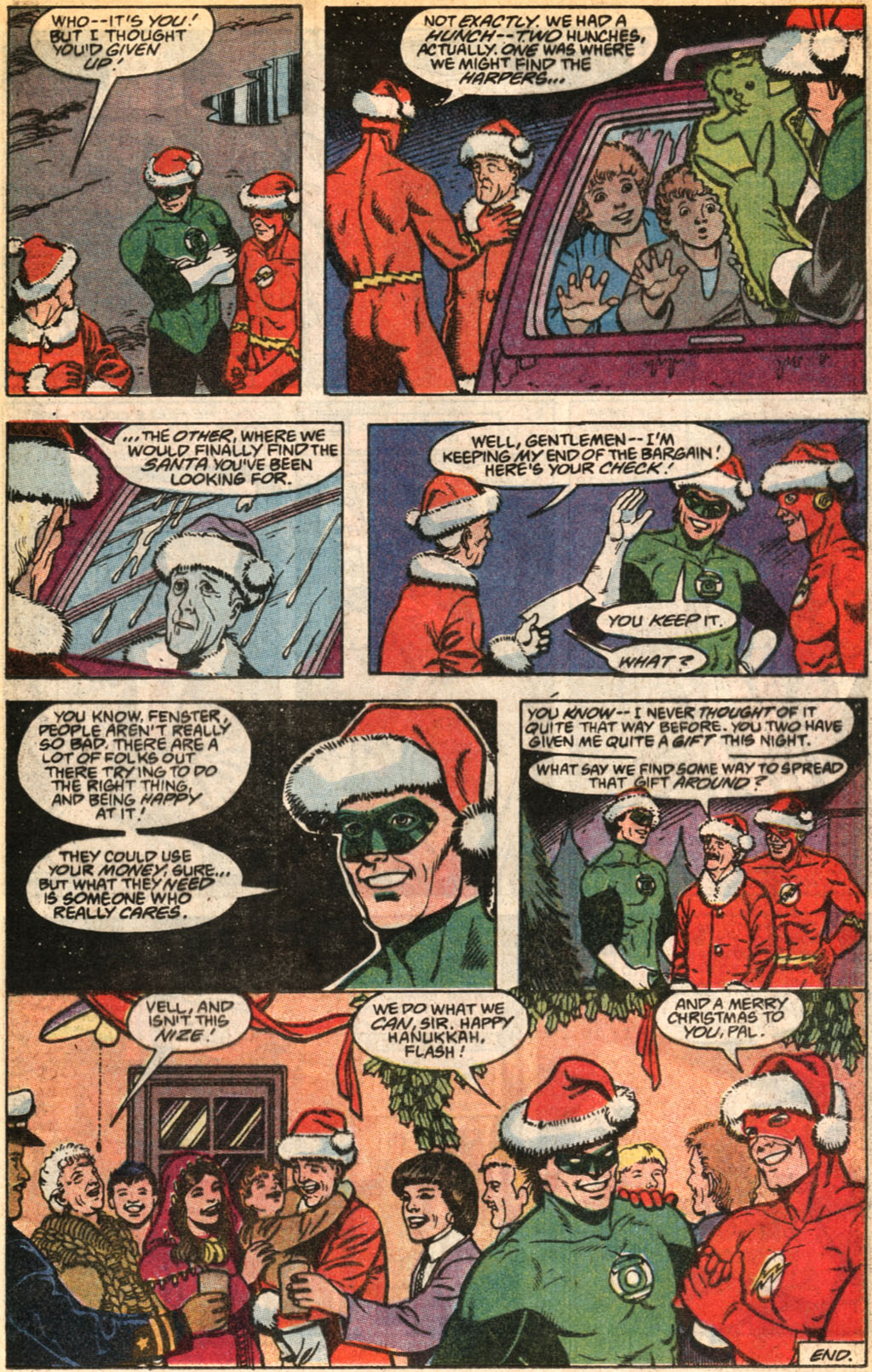
Thoughts: A wonderful, light-hearted tale from Bill Loebs, with the two best friends of the superhero world, who help a cynical man find the true spirit at the heart of Santa, sharing our bounty with people in need, whatever the need: food and shelter for the hungry and cold, a hand with mechanical things, restoring belief in the eyes of those losing faith, companionship to those who are alone. Most of all, sharing ourselves with other human beings.Fenster learns that Santa lives in all, when we give of ourselves.
Should Auld Acquaintance Be Forgot
Story by Alan Brennert, art by Dick Giordano, letters by Steve Haynie, colors by Tom McCraw, edited by Mark Waid
Boston Brand inhabits the body of a corporate raider and uses his credit cards to send expensive presents to his friends at the Hills brothers Circus. He has him call his office and orders 6 weeks severance to those laid off when he sold off a supermarket chain he acquired and downsized it. He moves on, feeling down. He comes across ice skaters and inhabits a young woman, enjoying her body as she gracefully executes figure skating moves. he moves on to a young man, skating with a beautiful woman. they go off to a Christmas party and he shares gifts and warmth and even kisses, then feels ashamed and leave the man to his friends and family. He rails against Rama Kushna, who prevented his spirit from leaving the plane of existence to help others. As he sits in his depths a woman comes along and responds to him, asking if that's why he does it. he thinks she is a supernatural figure, like Madame Xanadu. The blond woman replies no, and then asks if it matters how she can see him? She says she can leave if he ants, but he needs to be with someone tonight. he vents his frustration and she assks if that is what really bothers him, that people don't know what he does for them? He responds in anger that it gnaws at him and she asks if that is his motivation, glory?
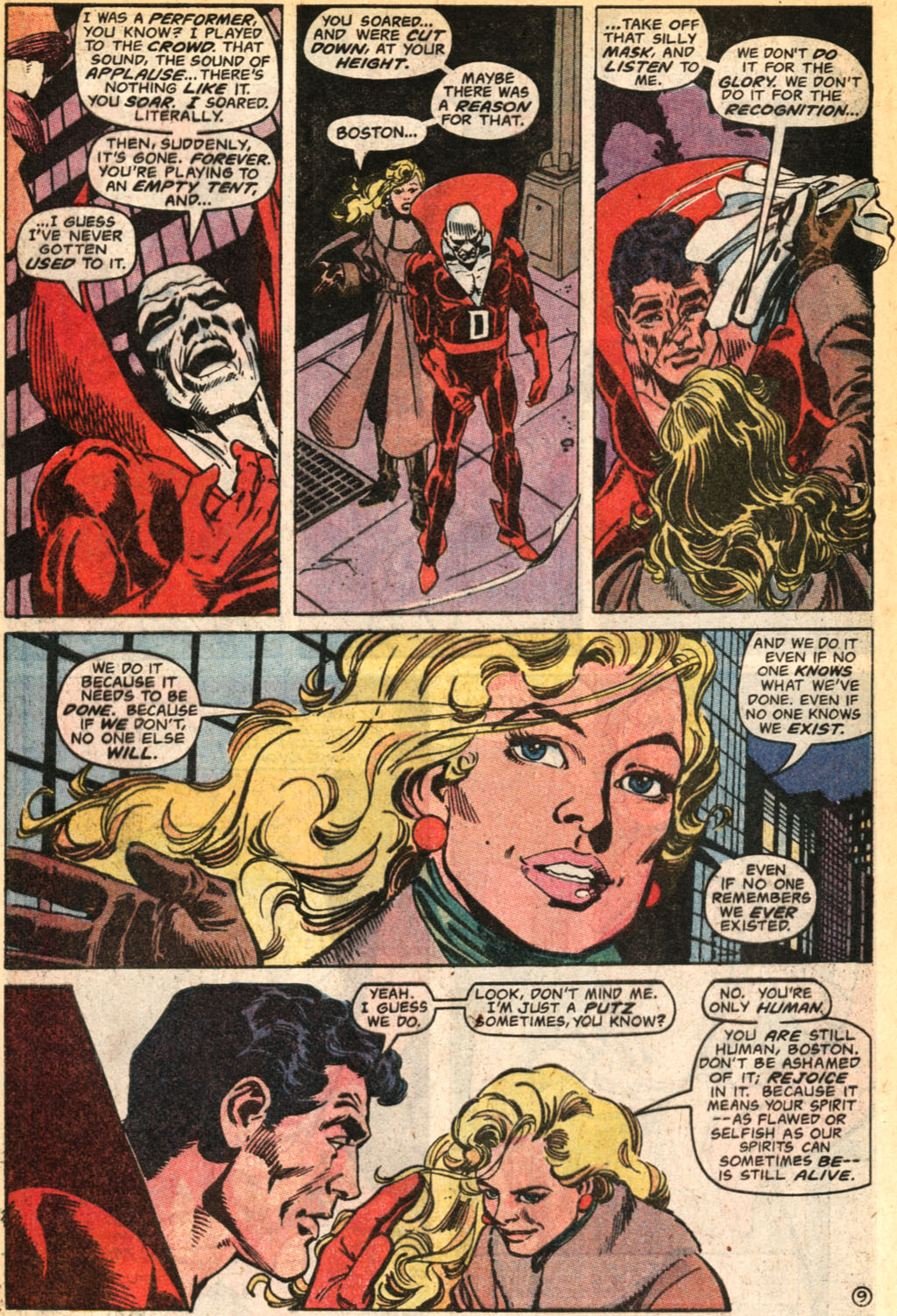
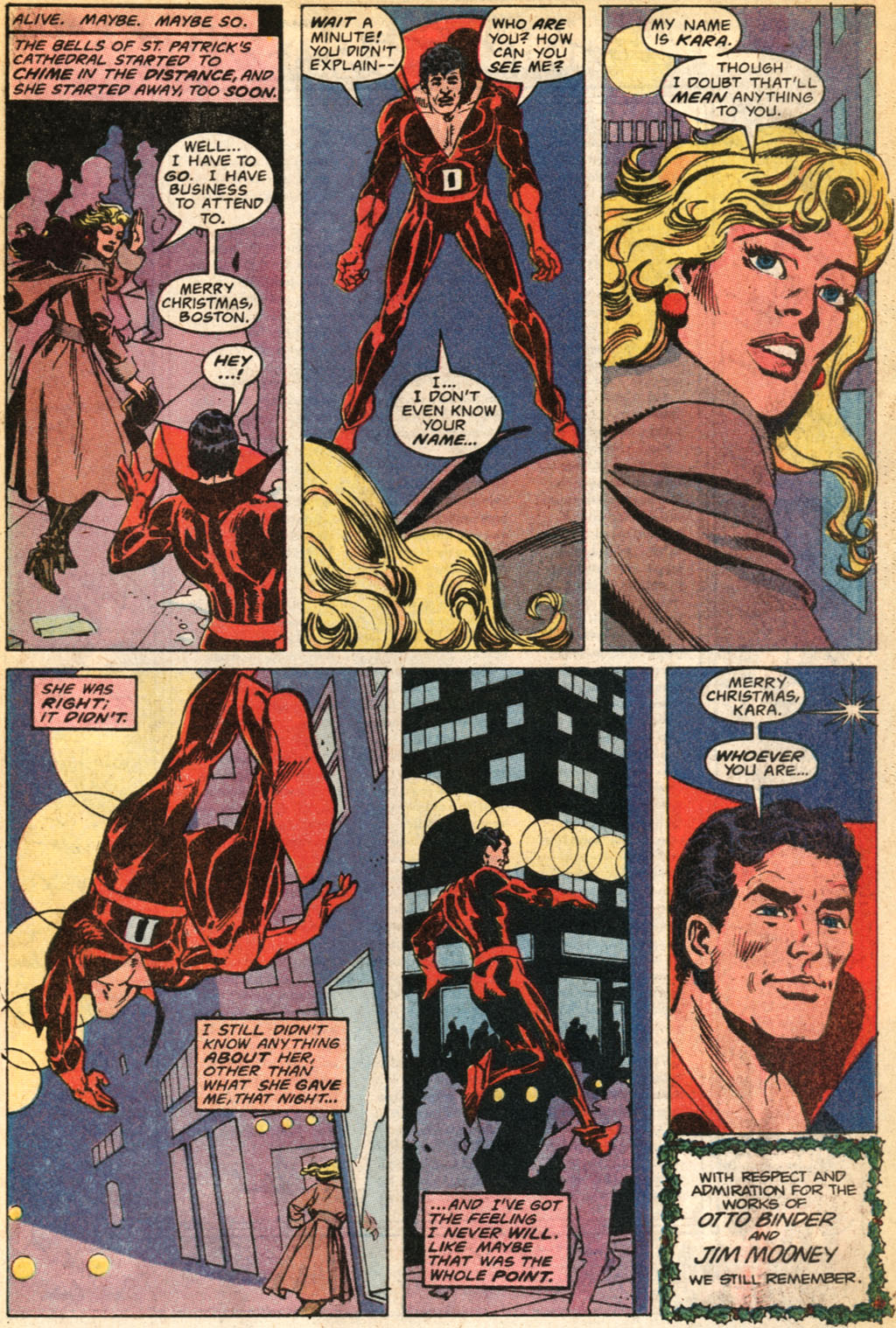
Thoughts: Merry Christmas, indeed, Kara. We do still remember you. We have all remarked about this amazing story this season and there isn't much more to be said. In two pages, Alan Brennert sums up true heroism so succinctly to be astounding. He does it with such quiet grace and wisdom that it overwhelms us. He also succeeds in giving us the essence of Supergirl, in just a few words and why her loss means so much to us, who knew her before her sacrifice and why her death was the true emotional depth to the Crisis on Infinite Earths and not Barry Allen's. Barry was a great hero, but the Flash would live on, in Wally, who kept Barry's memory alive. He still existed in the new universe, in the past. Kara Zor-El was taken from us and erased, to be replaced by surrogates and imposters. This allowed us to have her with us, for one brief moment. As Superman says in the opening story, who wouldn't give anything to have one more moment with a missing loved one?
I have always loved this story and I cry every time I read it. it is filled with true warmth and humanity. It has a special meaning this year, as this is the first Christmas without my mother; without either parent. My father died in 2008, on December 27. My Mother died this year, in September. I still have family close by and spent Christmas with my aunt and uncle and my wife and cat. Still, the holidays make yo reflect on those who are now gone. Alan Brennert understood this and gave us back Kara Zor-El, for one little story, where she gives of her humanity to another spirit in need, reminding him what a true hero is. My parents have always been my heroes and this story makes me remember why, and for that, I thank Alan Brennert.

Detective Comics #600 featured the conclusion to a story by Batman movie scripter Sam Hamm, with art by Denys Cowan and Dick Giordano. At the back of the book were tributes from noted artists and writers. Alan Brennert contributed a text piece, with a Berni Wrightson illio, in the background...

Brennert refutes the then-popular (and since, really) notion that Batman is psychotic. Brennert points out how people channel anger over injustice and equates that with Batman, rather than psychoses. this is why I wasn't wholly satisfied with the Burton Batman and had major issue with the sequel, and most movies ever since. The animated series guys "got it," where the live action people didn't; Batman was obsessed; but, he wasn't nuts. Hollywood struggled to portray the analytical side and none of the films really feature much detective work, beyond stumbling over obvious clues, or gaining info through fantasy technology. BTAS and Brenenrt's stories had actual detective work.
That was Brennert's sole contribution; but, he did contribute another story to DC, later in the year....
Christmas with the Super-Heroes #2

This issue features some great Christmas stories. Since we have discussed the Alan Brennert tale a great deal, in the Twelve Days of Christmas thread, I want to highlight the others, as well as share my thoughts on the Brennert story.
Ex-Machina
Story and art by Concrete creator Paul Chadwick, letters by John Costanza, colors by Tom McCraw, edited by Mark Waid.
On a snowbound highway, a man tries to flag down help. No one will stop. He collapses in despair and pulls a revolver out of the glove compartment and writes a suicide note. There is a knock on the window...
Superman listens to the man's story and empathizes with him. He and his wife have split and he is estranged from his daughter. he has a debilitating disease that affects the skin and muscles. Superman encourages him to get in touch with his daughter and tells him that anyone who has lost a parent would be glad to have them again, even for a short moment, from his own experience. Superman hand turns the generator to charge the car battery and gives the man directions to some friends in the area who can help, telling him he will call ahead and alert them. He tells the man to take the next exit, but to keep these people secret, as they are good friends and private people. The man heads on down the road and takes the next exit, to Smallville.
Thoughts: This is a nice, quiet tale, in Chadwick's tradition in his Concrete tales. It is filled with humanity and demonstrates why Superman can be such a powerful character, in the right hands. All he does is sit down and listen to the man, letting his voice be heard by someone who truly cares. He helps him get back on the road and direct him to others, who care about their fellow human beings. The superpowers are minimal, the humanity is enormous. It is the spirit of Dickens and Phillip Van Doren Stern (author of the original short story, It's a Wonderful Life). Peace on Earth, Good Will to all Mankind. All Men and Women are our brothers and sisters and the more we embrace that, the better the world becomes. Superman, an orphan from another world, was taught to care for all life, by two humans, who took him in and shaped who he became. That nobility is what makes Superman who he is, not the powers and too many writers and artists can't grasp that.
And in the Depths
Story by Dave Gibbons, art by Gray Morrow, letters by John Costanza, edited by Mark Waid
The story is the tale of the Batcave, as we see it across centuries and decades, as the shadows create darkness and terror, until a boy named Bruce stumbles into it. His world becomes darkness and he reenters the cave and creates a base from which to gain revenge. Then light comes to him in a child, who becomes a partner and the darkness fades...
The boy grows to be a man and goes out on his own, and darkness returns. However, at the end, as a stricken robin falls into the cave and is about to become prey for the bats, we see it fight back and scare away the bats, as we see the costume in the background and light returns.
Thoughts: Gray Morrow's art makes it look great; Dave Gibbons tells an interesting tale and illustrates how Bruce extending his humanity to another helps push back against the darkness. It's not as effective as the Superman story, or the Brennert tale; but, it's a good effort, especially since Gibbons isn't primarily a writer.
Gifts
Story and art by Eric Shanower, colors by Tom McCraw, edited by Mark Waid
Christmas at Julia Kapatelis house. Julia sees the arrival of an old college friend, Sharon Jackson. They have seen each other since Sharon's wedding; but, she confesses that her husband is divorcing her, after he has an affair with a woman on the church council (Sharon is a pastor). Church guidelines state she most go to a new congregation, after a divorce and she is afraid of starting over and is thinking of going backto school, to finish her doctorate. Julia lends a sympathetic ear and Sharon stays with her for the holidays. Diana shows up and surprises Sharon, and they talk briefly, about what a pastor does and about Diana's mission and heroics and see their commonality in their beliefs. They listen to crolers and Diana takes part in a Christmas Eve service at the church. That night, Sharon is putting out some final presents and finds Diana staring out the window. Diana breaks down and shares her crisis of faith over her mission...
Sharon helps Diana find the strength to carry on, that each it of good plants a seed in others that will grow. In so doing, it helps restore Sharon's own faith in her ability as a pastor and she tells Julia, in the morning, that she will return to the ministry and go to a new congregation that needs her.
Thoughts: Another gentle tale showing how Diana's core beliefs are no different from those at the heart of other religions and philosophies and how that commonality allows a Christian pastor to counsel her about her gifts and her mission and restores her faith in herself. In the process, Diana's need for Sharon's counsel restores Sharon's faith in her own mission to minister to others. Both women share fundamental beliefs and both face doubts i their ability to relate those beliefs to help others; yet, in comforting each other, they restore their faith and continue in their similar missions. The story is reverent to both Christian core belief and Diana's message, derived though it may be from what a Christian might call pagan belief. It reminds us that most religions share the same message, when you look beyond the surface; how to live in eace with one another and share love with others. For that peace and love to come, we must look beyond the differences and focus on the commonalities. Again, humanity is a central theme. Our heroes take a moment to share human failings and triumphs and help a fellow human in need.
Silent Night Story and pencils by John Byrne, finishes by Andy Kubert, colors by Glenn Whitmore, edited by Mark Waid. Dedicated to Joe Kubert and Robert Kanigher.
Christmas, some time during World War I. Ata hospital, a nurse tends to wounded airmen on the Allied side. A young pilot, with head wounds, sketches the pane of the man who shot him down: Rittmeister Hans Von Hammer. Another man tears them out of the nurse's hands and berates the pilot for glorifying their enemy. We see the list of names of men missing or dead. We also see that they have been without supplies for days and food is becoming scarce. Then, they hear a noise and see an aircraft land. It is a Fokker DR7 Triplane, and it is the aircraft of Von Hammer. He presents the hospital with packages of food and is invited to join them in a feast. He dances with the pretty nurse, then sees the board of the missing and dead and renders honors to them...
The young pilot turns a revolver on him and is ready to fire. Von Hammer does nothing, as he understands. The youth is stopped by the other pilot who tore up his drawings. He points to the sky, reminding the lad it is Christmas, and a truce. He then points outside and Von Hammer departs, paying his respects to the nurse as he goes. he flies away, leaving behind the fellowship that was there, for a brief moment.
Thoughts: John Byrne perfectly captures the look and tone of the Enemy Ace stories, as the honorable Von Hammer offers his own tribute and fellowship during a Christmas truce. We are reminded of the Christmas miracle of the winter of 1914, when both sides stopped killing one another, in respect for the season. Carols broke out across no man's land and the soldiers rose out of the trenches and extended their hands in friendship, rather than bayonets. They exchanged food and cigarettes, shared photos of family and played football, sharing their humanity. It came to an end and they return to their own sides and then resumed killing one another, after the truce. It was not repeated, though there were still tales of individual incidents, as the war dragged on. The story is told silently, fitting the title, with the art carrying the story and emotion and it is one of Byrne's best jobs, even as he tries to capture the style of Kubert (aided by Andy's inks, no doubt). It emphasizes the triumph of the human spirit, and the stupidity of war, that moments like that couldn't get men to see that the bloodshed was accomplishing nothing and that it needed to stop, permanently. No matter how many times we go through this, we never seem to learn the lesson, that all life is sacred and we share more in common than our national identities and political ideologies illustrate.
An Old Fashioned Christmas
William Messner-Loebs-story, Colleen Doran-pencils, Ty Templeton-inks, Albert De Guzman-letters, Tom McCraw-colors, edited by Mark Waid
In a tale from the past, Hal Jordan joins Barry Allen on monitor duty. When Barry's shift is up, the friends go in search of an old fashioned Christmas. They beam down, but find it rainining, instead of snow. They give some money to a street corner Santa, who talks about how people are nothing, without money. They are having trouble finding the Christmas spirit and a cry for help gets them to stop some muggers. Their victim is CB Fenster, one of the richest men on Earth. He decries how small and petty people are and relate how he offered his guests $5 million to prove the existence of Santa. He remembers a time, wehn he was young, when Santa seemed to exist and people were kind. Flash and GL set out to prove him wrong. Flash gets presents from stores in Hawaii, while GL fashions a Santa suit for Fenster. They take him around to be Santa and help him get down chimneys. he gives a teddy bear to a pair of kids, who thought he'd be more inspiring. He helps a rich widow assemble bikes that her late husband ordered before his death. he meets an elderly Jewish man, who works so that Christians can spend time with family, who would just like some company. They look for the Harper family, the last on the list, but find only a burnt down house. Flash and GL give up and Fenster finds the family, sleeping in their car, unable to afford a place to stay. He offers them presents but the father tells him to take them to the shelter, where others are worse off. he has sardines for his wife and a silk rose he found outside a florist and is happy. Flash and GL return and Flash tells Fenster they have found the Santa Fenster was looking for and show him his own reflection. he starts to hand them the money and they refuse, saying use it to help others.
Thoughts: A wonderful, light-hearted tale from Bill Loebs, with the two best friends of the superhero world, who help a cynical man find the true spirit at the heart of Santa, sharing our bounty with people in need, whatever the need: food and shelter for the hungry and cold, a hand with mechanical things, restoring belief in the eyes of those losing faith, companionship to those who are alone. Most of all, sharing ourselves with other human beings.Fenster learns that Santa lives in all, when we give of ourselves.
Should Auld Acquaintance Be Forgot
Story by Alan Brennert, art by Dick Giordano, letters by Steve Haynie, colors by Tom McCraw, edited by Mark Waid
Boston Brand inhabits the body of a corporate raider and uses his credit cards to send expensive presents to his friends at the Hills brothers Circus. He has him call his office and orders 6 weeks severance to those laid off when he sold off a supermarket chain he acquired and downsized it. He moves on, feeling down. He comes across ice skaters and inhabits a young woman, enjoying her body as she gracefully executes figure skating moves. he moves on to a young man, skating with a beautiful woman. they go off to a Christmas party and he shares gifts and warmth and even kisses, then feels ashamed and leave the man to his friends and family. He rails against Rama Kushna, who prevented his spirit from leaving the plane of existence to help others. As he sits in his depths a woman comes along and responds to him, asking if that's why he does it. he thinks she is a supernatural figure, like Madame Xanadu. The blond woman replies no, and then asks if it matters how she can see him? She says she can leave if he ants, but he needs to be with someone tonight. he vents his frustration and she assks if that is what really bothers him, that people don't know what he does for them? He responds in anger that it gnaws at him and she asks if that is his motivation, glory?
Thoughts: Merry Christmas, indeed, Kara. We do still remember you. We have all remarked about this amazing story this season and there isn't much more to be said. In two pages, Alan Brennert sums up true heroism so succinctly to be astounding. He does it with such quiet grace and wisdom that it overwhelms us. He also succeeds in giving us the essence of Supergirl, in just a few words and why her loss means so much to us, who knew her before her sacrifice and why her death was the true emotional depth to the Crisis on Infinite Earths and not Barry Allen's. Barry was a great hero, but the Flash would live on, in Wally, who kept Barry's memory alive. He still existed in the new universe, in the past. Kara Zor-El was taken from us and erased, to be replaced by surrogates and imposters. This allowed us to have her with us, for one brief moment. As Superman says in the opening story, who wouldn't give anything to have one more moment with a missing loved one?
I have always loved this story and I cry every time I read it. it is filled with true warmth and humanity. It has a special meaning this year, as this is the first Christmas without my mother; without either parent. My father died in 2008, on December 27. My Mother died this year, in September. I still have family close by and spent Christmas with my aunt and uncle and my wife and cat. Still, the holidays make yo reflect on those who are now gone. Alan Brennert understood this and gave us back Kara Zor-El, for one little story, where she gives of her humanity to another spirit in need, reminding him what a true hero is. My parents have always been my heroes and this story makes me remember why, and for that, I thank Alan Brennert.










